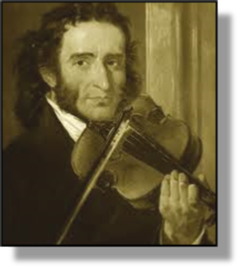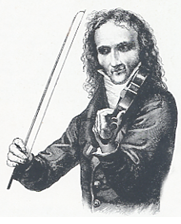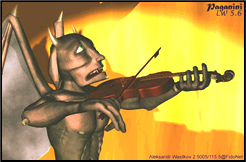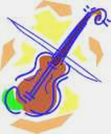


xxxxxThe Genoan virtuoso Niccolò Paganini, one of the world’s greatest violin players, began a tour of Italy in 1813. This proved so successful that in 1828 he made a concert tour of Europe, visiting over 40 cities, including Vienna, Paris and London. His technical skill was so astonishing that some believed he was in league with the Devil. As a composer he produced a variety of works, including concertos, sonatas and quartets for violin, viola, cello and guitar. His capriccios in particular -
NICCOLÒ PAGANINI 1782 -
 xxxxxThe Italian violinist and composer Niccolò Paganini was born in Genoa and, after receiving instruction from his father and local musicians, he made his first appearance as a violin soloist at the age of nine. However, apart from a successful tour of Lombardy four years later, accompanied by his father, he remained in his home town until 1805, when he became musical director at the court of Napoleon’s sister, Elisa Bacciocchi, Princess of Lucca. There, as in Genoa, he indulged himself in the social pleasures, being particularly fond of gambling and the ladies, and not necessarily in that order.
xxxxxThe Italian violinist and composer Niccolò Paganini was born in Genoa and, after receiving instruction from his father and local musicians, he made his first appearance as a violin soloist at the age of nine. However, apart from a successful tour of Lombardy four years later, accompanied by his father, he remained in his home town until 1805, when he became musical director at the court of Napoleon’s sister, Elisa Bacciocchi, Princess of Lucca. There, as in Genoa, he indulged himself in the social pleasures, being particularly fond of gambling and the ladies, and not necessarily in that order.
xxxxxHis career as a violin virtuoso began in 1813, when he left Lucca and went on a tour of Italy, giving recitals of his own compositions in many towns throughout the country. Such was the interest and acclaim he aroused that in 1828 he embarked on a tour of Europe. Over the next five years he made sensational appearances in some 40 towns in Germany, Bohemia and Poland, as well as the cities of Vienna, Paris and London. By the time he had concluded his travels with a triumphant tour of England and Scotland in 1832, he was not only well known throughout the continent, but also very wealthy. The following year he settled in Paris, and it was here that he met the young French composer Hector Berlioz and commissioned him to write his symphony Harold en Italie. After the failure of his Casino Paganini, a gambling house in which he had invested much money, he went to Marseille in 1839, and then to Nice. It was here on a May evening that, suffering from a fever, he collapsed and died while playing his violin.
 xxxxxHis sensational success -
xxxxxHis sensational success -
 xxxxxIndeed, the story goes that while performing in Vienna, one member of the audience was so overcome by his frenzied playing that he vowed that he had seen the devil at his elbow. It was perhaps from this incident that the rumour grew that Paganini was in league with some form of supernatural power or, indeed, had a pact with the devil himself -
xxxxxIndeed, the story goes that while performing in Vienna, one member of the audience was so overcome by his frenzied playing that he vowed that he had seen the devil at his elbow. It was perhaps from this incident that the rumour grew that Paganini was in league with some form of supernatural power or, indeed, had a pact with the devil himself -
xxxxxFor his music he drew upon folk and gypsy themes, often purposefully constructed so as to demonstrate his outstanding virtuosity, not only on the violin, but also on the viola, mandolin and guitar. Included among his compositions were six violin concertos (the first being especially popular), twelve sonatas for violin and guitar, variations for violin and orchestra, quartets for violin, viola, cello and guitar, and twenty-
 xxxxxPaganini revolutionised the technique of playing the violin, and is considered by some as the greatest violinist of all time. Furthermore, by his very extraordinary talent and intriguing personality, he inspired the Romantic image of the virtuoso genius. He was, perhaps, the first “pop star”. His playing influenced, above all, the Hungarian composer Franz Liszt, whom he met in Paris in 1831, and the German composer Robert Schumann, who also attended one of his performances. Both were inspired to work harder at their piano playing! He also encouraged and financially helped the young French composer Hector Berlioz, and, later, themes from his capriccios inspired works by Johannes Brahms and Sergei Rachmaninoff.
xxxxxPaganini revolutionised the technique of playing the violin, and is considered by some as the greatest violinist of all time. Furthermore, by his very extraordinary talent and intriguing personality, he inspired the Romantic image of the virtuoso genius. He was, perhaps, the first “pop star”. His playing influenced, above all, the Hungarian composer Franz Liszt, whom he met in Paris in 1831, and the German composer Robert Schumann, who also attended one of his performances. Both were inspired to work harder at their piano playing! He also encouraged and financially helped the young French composer Hector Berlioz, and, later, themes from his capriccios inspired works by Johannes Brahms and Sergei Rachmaninoff.
xxxxxIncidentally, during one of his gambling sessions Paganini was forced to pawn his violin to pay an outstanding debt. A wealthy French merchant loaned him a Guarneri violin and, on hearing him play it, was so impressed that he made it a gift. Paganini treasured that violin and later, when he bought a Stradivarius, he bequeathed it to the city of Genoa, where it remains to this day. Likewise, we are told that the Italian composer Gioacchino Rossini was moved to tears when he heard Paganini play. ……
xxxxx…… Rightly or wrongly, Paganini earned a reputation for being mean. However, after the premier of Harold en Italie, a work composed by the young Hector Berlioz for the violin virtuoso, it is reported that Paganini knelt at his feet in homage to “Beethoven’s successor”. The next day the struggling young Berlioz received a letter from Paganini repeating his prediction and enclosing 20,000 francs. Berlioz was able to take time off to compose his choral symphony Romeo and Juliette, and he then dedicated this work to his generous patron. ……
xxxxx…… In the 20th century the Hungarian composer of light opera, Franz Lehar, produced an operetta entitled Paganini.
G3c-
Acknowledgements
Paganini: 19th century, artist unknown – Conservatory of St. Peter, Naples, Italy. Playing: after the German artist Karl Joseph Begas (1794-


